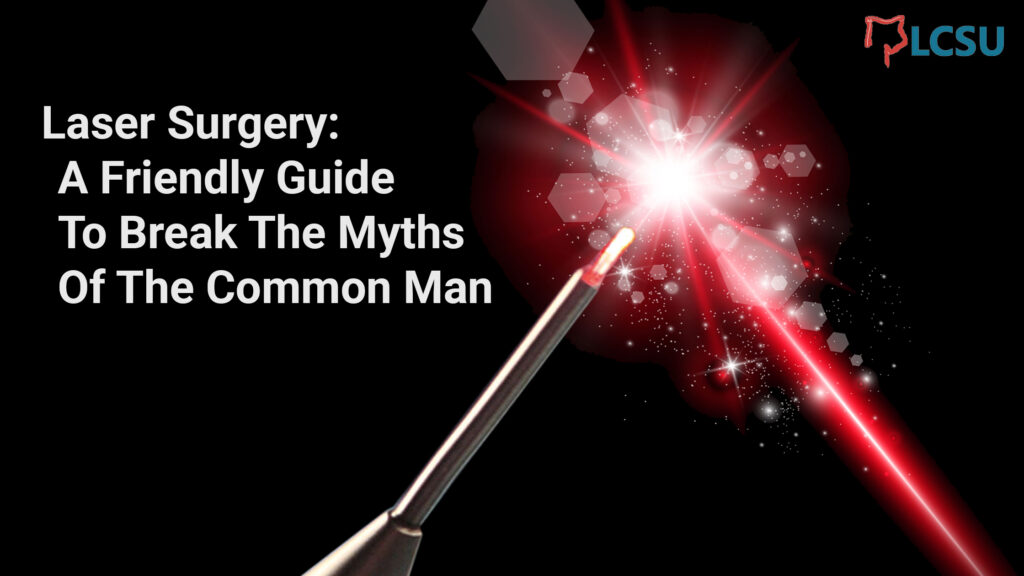Laser Surgery: A Friendly Guide to Break The Myths of The Common Man
Here are a few lines to give friendly guidance about Laser Surgery where LASER stands for “Light Amplification by the Stimulated Emission of Radiation”, it is a type of surgery done using a special light source instead of instruments like scalpels for surgical procedures.
Laser Surgery, these words themselves have a lot of attraction for patients without any medical knowledge. There are lots of misunderstandings or we can call it myths rumoring among the common man when it comes to Laser Surgery, and the most common ones are painless or lesser pain, small or no cuts, no marks, speedy recovery, etc.
Unfortunately, these terms themselves are blurred, and in our country, these terms are used rampantly to promote a surgeon hospital or institution without any evidence behind it.

So, What is Laser Surgery?
Laser is a light source that has different properties causing changes in the target tissues depending on their type. The Laser light can be delivered either continuously or periodically. Also, Laser can be used with fiber optics to treat certain parts of the body that are difficult to access. The commonest specialties laser is used is for eyes i.e. LASIK treatment, skin diseases, and varicose veins.
There are many different types of Lasers each performing specific functions during surgery. Some of the Laser types and their uses are as follows:
Nd:YAG Laser
Nd:YAG (stands for Neodymium:yttrium-aluminum-garnet) Lasers are used to penetrate deeper into tissue and to cause blood to clot quickly. This laser light can be carried through fiber optics to treat certain parts of the body that are difficult to access. For eg., this laser is used to treat throat cancer.
Carbon Dioxide (CO2) Laser
CO2 Laser is used to removing a very thin layer of tissue from the skin’s upper surface without disturbing the deeper layers. For eg., it can be used for skin cancers.
Laser-induced interstitial thermotherapy (LITT)
LITT is used to heat certain parts of the body. This laser is directed towards the areas between organs in the interstitial areas (that are near a tumor). The heat generated by the laser increases the temperature of the tumor to shrink or destroy the cancer cells.
Infrared Laser
An infrared laser is a laser with many capabilities even though its cost is too low. While operating, the Laser emits radiation (with a particular range) in the “eye-safe” part of the electromagnetic spectrum, where light is largely absorbed by the cornea and lens, without reaching the retina.
Diode Laser
Diode lasers are used for oral soft tissue surgery and especially small prominent lesions because of their easy application, better coagulation, less swelling, and pain, and their capability for the treatment of physiologic gingival pigmentation.
However, all the lasers can be harmful if not handled properly.
Laparoscopic Surgery & Laser Surgery
Many patients get confused with laser surgery as keyhole or laparoscopic surgery as cuts are small in this type of surgery as well. Many surgeons also promote laparoscopic surgery as laser surgery adding to the confusion.
Though both laparoscopic surgery and the use of laser result in lesser pain and faster recovery, yet there is no comparison between the two as keyhole laparoscopic surgery is a proper surgery performed in a minimally invasive method while the laser is the use of light and heat source to achieve the results.
Note of Cautions
As the pros of Laser Surgery are visible and known to many, cons are not known to many. There are side effects mostly occurring in every post-laser surgery like dry eyes, glare, halos, double visible, astigmatism, flap problems, vision loss or changes, etc. Also, there is no surety of 100% recovery.
So, before going for any laser surgery for eg., for piles, fissures, fistula, it is important to determine whether there is any evidence to show that it is an acceptable treatment method or not.
In India, there are enough self-proclaimed laser surgeons, untrained Ayurveda doctors, and quacks who will offer you laser treatment without discussing the pros and cons of laser, recurrence rate, and most importantly whether it is acceptable treatment in worldwide literature.
Conclusion
Many laser treatments do more harm than good and unfortunately, the common man falls prey because of fear of surgery and attraction of a quick painless procedure.
So sincere advice to patients looking for a quick and easy fix to a problem to be careful and proactive to find out if treatment is evidence-based and whether it is likely to give you a good permanent solution to your problems.


No Comments
Sorry, the comment form is closed at this time.